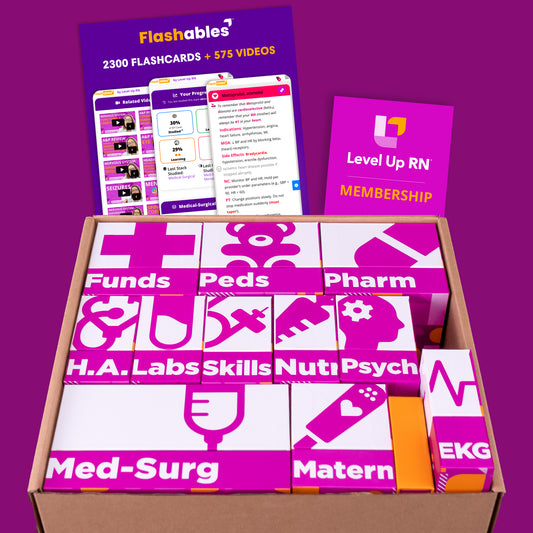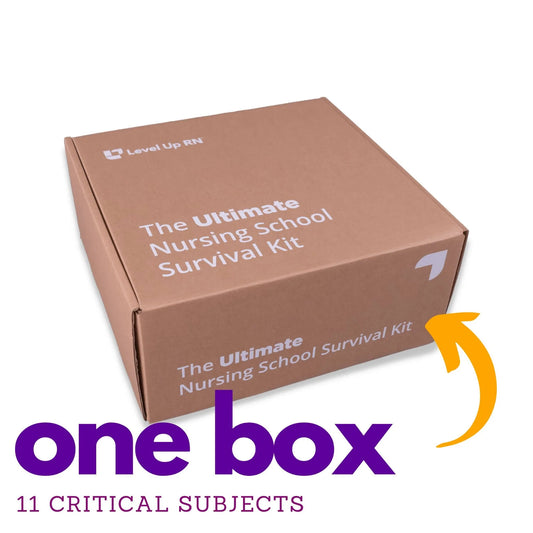Nursing Tips
Psychiatric Mental Health (45)
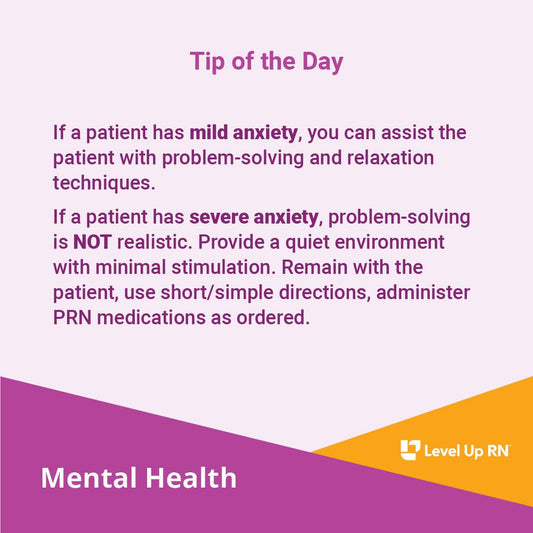
Mild and Severe Anxiety
For mild anxiety, you can assist the patient with problem-solving and relaxation techniques. For severe anxiety, problem-solving is NOT realistic.
Mild and Severe Anxiety
For mild anxiety, you can assist the patient with problem-solving and relaxation techniques. For severe anxiety, problem-solving is NOT realistic.
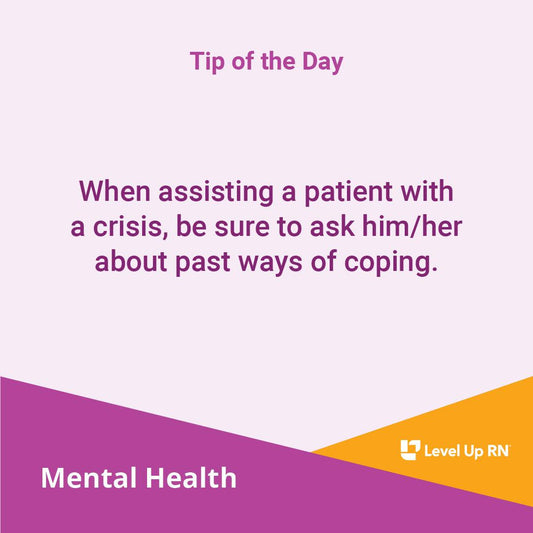
Patients in a crisis
When assisting a patient with a crisis, be sure to ask him/her about past ways of coping.
Patients in a crisis
When assisting a patient with a crisis, be sure to ask him/her about past ways of coping.
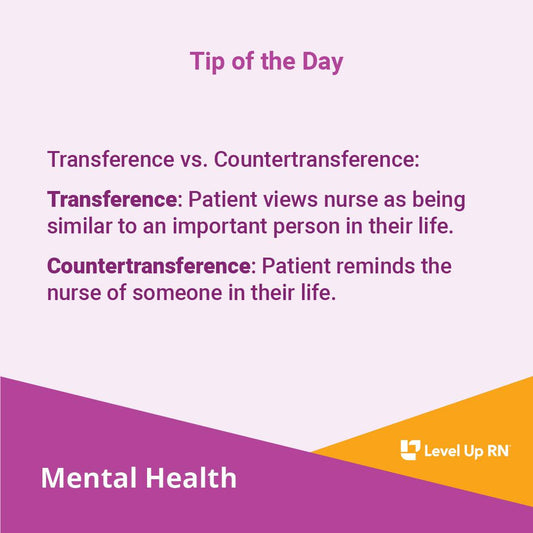
Transference vs. Countertransference
Transference vs. Countertransference: Transference: Patient views nurse as being similar to an important person in his/her life. Countertransference: Patient reminds the nurse of someone in his/her life.
Transference vs. Countertransference
Transference vs. Countertransference: Transference: Patient views nurse as being similar to an important person in his/her life. Countertransference: Patient reminds the nurse of someone in his/her life.
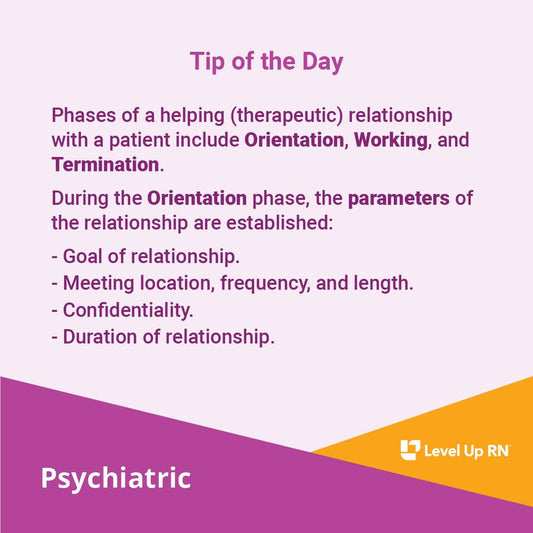
Phases of Helping Relationships
Phases of a helping (therapeutic) relationship with a patient include Orientation, Working, and Termination.
Phases of Helping Relationships
Phases of a helping (therapeutic) relationship with a patient include Orientation, Working, and Termination.
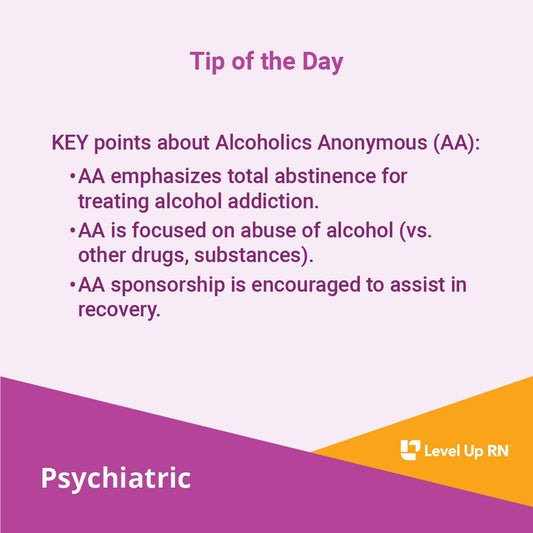
Key Principle from Alcoholics Anonymous
KEY points about Alcoholics Anonymous (AA).
Key Principle from Alcoholics Anonymous
KEY points about Alcoholics Anonymous (AA).
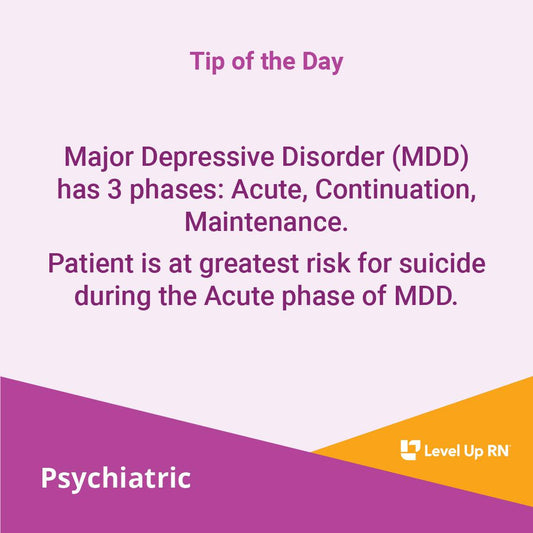
Major Depressive Disorder Phases
Major Depressive Disorder (MDD) has 3 phases: Acute, Continuation, Maintenance. Patient is at greatest risk for suicide during the Acute phase of MDD.
Major Depressive Disorder Phases
Major Depressive Disorder (MDD) has 3 phases: Acute, Continuation, Maintenance. Patient is at greatest risk for suicide during the Acute phase of MDD.
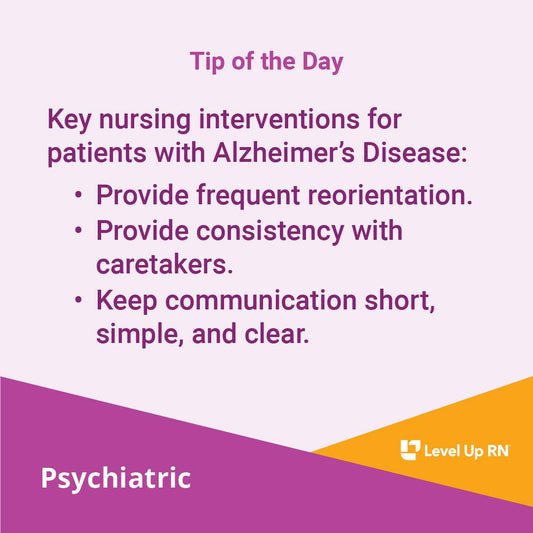
Alzheimer's Disease Key Interventions
Key nursing interventions for Alzheimer's Disease: Provide frequent reorientation, consistency with caretakers; Keep communication short, simple, and clear.
Alzheimer's Disease Key Interventions
Key nursing interventions for Alzheimer's Disease: Provide frequent reorientation, consistency with caretakers; Keep communication short, simple, and clear.
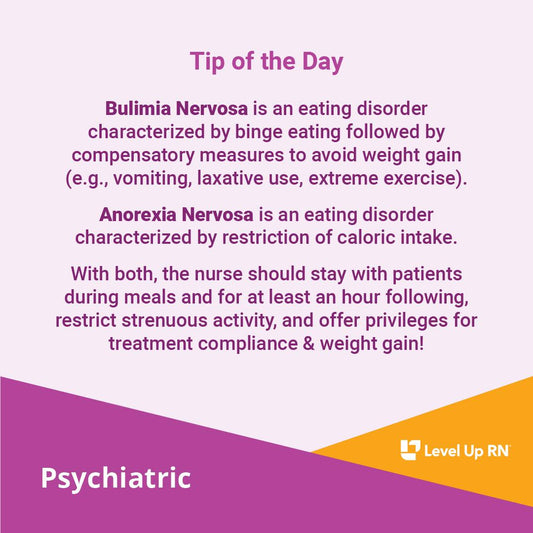
Eating Disorders
Bulimia Nervosa is an eating disorder characterized by binge eating followed by compensatory measures to avoid weight gain (e.g., vomiting, laxative use, extreme exercise). Anorexia Nervosa is an eating disorder characterized by...
Eating Disorders
Bulimia Nervosa is an eating disorder characterized by binge eating followed by compensatory measures to avoid weight gain (e.g., vomiting, laxative use, extreme exercise). Anorexia Nervosa is an eating disorder characterized by...
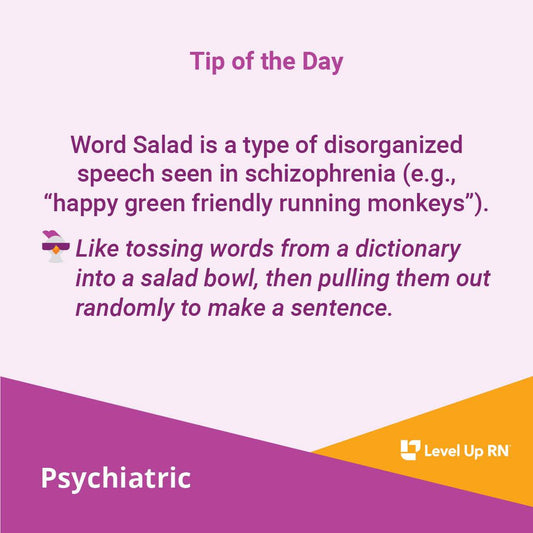
Word Salad
Word Salad is a type of disorganized speech seen in schizophrenia (e.g., "happy green friendly running monkeys").
Word Salad
Word Salad is a type of disorganized speech seen in schizophrenia (e.g., "happy green friendly running monkeys").
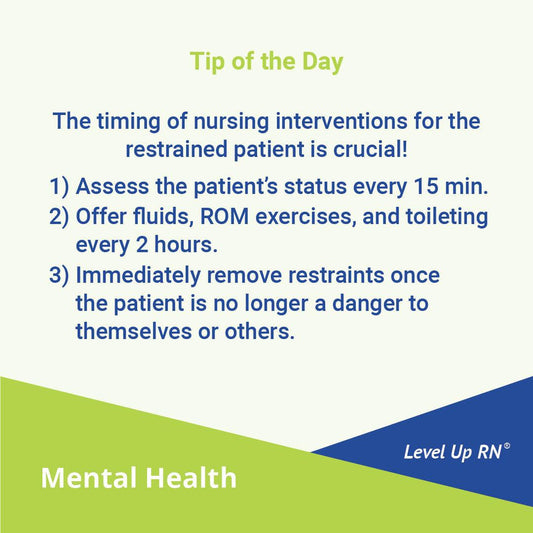
Nursing Interventions for the Restrained Patient
The timing of nursing interventions for the restrained patient is crucial! 1) Assess the patient's status every 15 minutes. 2) Offer fluids, ROM exercises, and toileting every 2 hours. 3)...
Nursing Interventions for the Restrained Patient
The timing of nursing interventions for the restrained patient is crucial! 1) Assess the patient's status every 15 minutes. 2) Offer fluids, ROM exercises, and toileting every 2 hours. 3)...
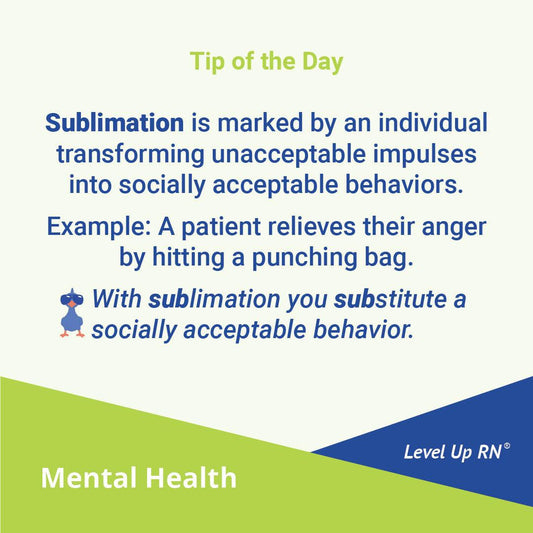
Sublimation
Sublimation is marked by an individual transforming unacceptable impulses into socially acceptable behaviors.
Sublimation
Sublimation is marked by an individual transforming unacceptable impulses into socially acceptable behaviors.
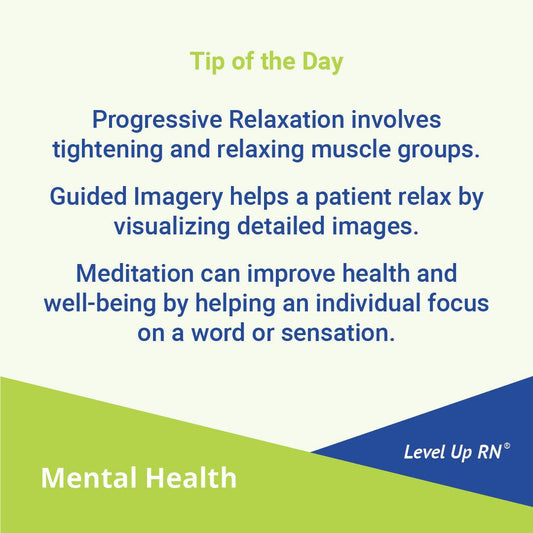
Therapeutic Relaxation Techniques
Progressive Relaxation involves tightening and relaxing muscle groups. Guided Imagery helps a patient relax by visualizing detailed images. Meditation can improve health and well-being by helping an individual focus on...
Therapeutic Relaxation Techniques
Progressive Relaxation involves tightening and relaxing muscle groups. Guided Imagery helps a patient relax by visualizing detailed images. Meditation can improve health and well-being by helping an individual focus on...
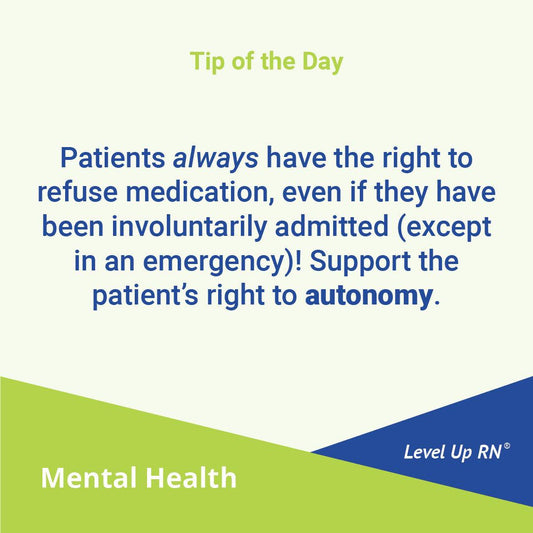
Right to Refuse Medication
Patients always have the right to refuse medication, even if they have been involuntarily admitted (except in an emergency)! Support the patient's right to autonomy.
Right to Refuse Medication
Patients always have the right to refuse medication, even if they have been involuntarily admitted (except in an emergency)! Support the patient's right to autonomy.
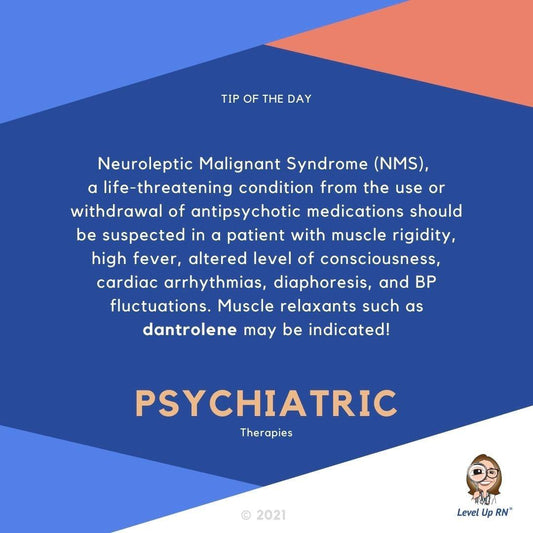
Neuroleptic Malignant Syndrome (NMS)
Neuroleptic Malignant Syndrome (NMS) is a life-threatening condition by the use or withdrawal of antipsychotic medications.
Neuroleptic Malignant Syndrome (NMS)
Neuroleptic Malignant Syndrome (NMS) is a life-threatening condition by the use or withdrawal of antipsychotic medications.
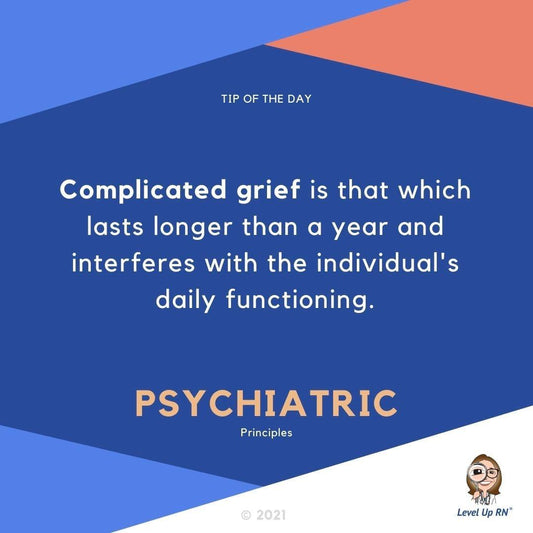
Complicated Grief
Complicated grief is that which lasts longer than a year and interferes with the individual's daily functioning.
Complicated Grief
Complicated grief is that which lasts longer than a year and interferes with the individual's daily functioning.
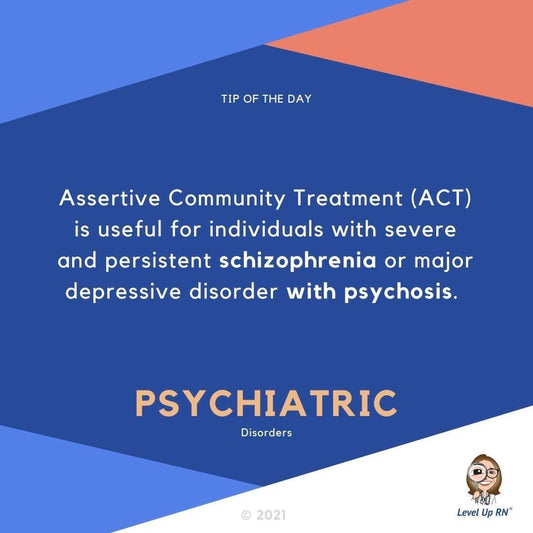
Assertive Community Treatment (ACT)
Assertive Community Treatment (ACT) is useful for individuals with severe and persistent schizophrenia or major depressive disorder with psychosis.
Assertive Community Treatment (ACT)
Assertive Community Treatment (ACT) is useful for individuals with severe and persistent schizophrenia or major depressive disorder with psychosis.
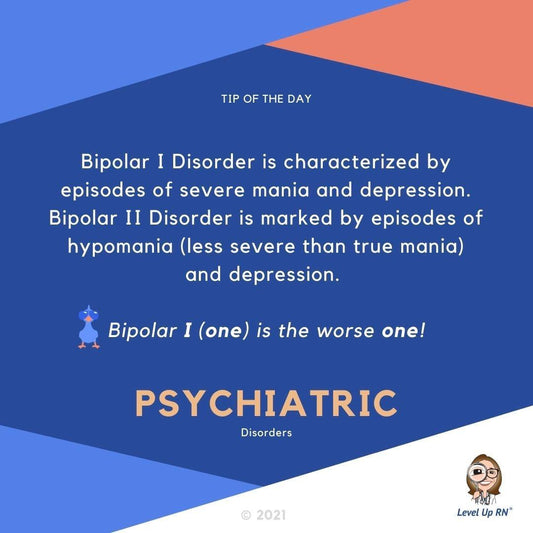
Bipolar Disorders: I and II
Bipolar I Disorder is characterized by episodes of severe mania and depression. Bipolar II Disorder is marked by episodes of hypomania (less severe than true mania) and depression.
Bipolar Disorders: I and II
Bipolar I Disorder is characterized by episodes of severe mania and depression. Bipolar II Disorder is marked by episodes of hypomania (less severe than true mania) and depression.
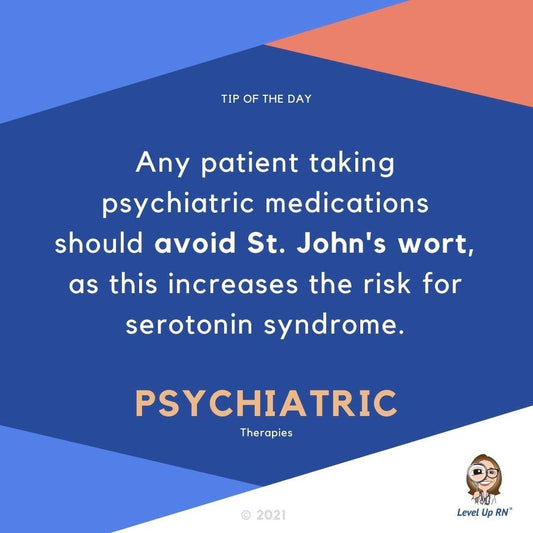
St. John's Wort and Serotonin Syndrome
Any patient taking psychiatric medications should avoid St. John's wort, as this increases the risk for serotonin syndrome.
St. John's Wort and Serotonin Syndrome
Any patient taking psychiatric medications should avoid St. John's wort, as this increases the risk for serotonin syndrome.
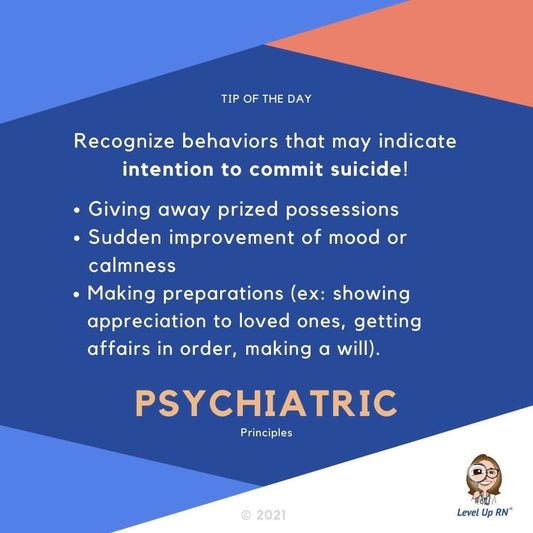
Indications of Intent to Commit Suicide
Recognize behaviors that may indicate an intention to commit suicide . For example: Giving away prized possessions, sudden improvement of mood or calmness, and/or making of final preparations.
Indications of Intent to Commit Suicide
Recognize behaviors that may indicate an intention to commit suicide . For example: Giving away prized possessions, sudden improvement of mood or calmness, and/or making of final preparations.
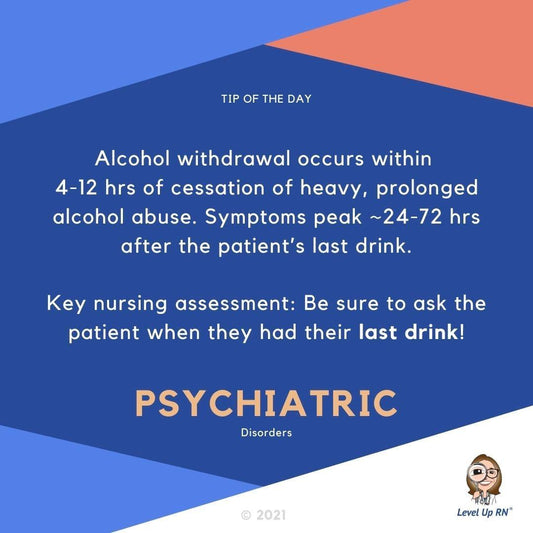
Alcohol Withdrawal
Alcohol withdrawal starts 4-12 hours after last drink and peaks at 24-48 hours. Be sure to ask the patient when they had their last drink!
Alcohol Withdrawal
Alcohol withdrawal starts 4-12 hours after last drink and peaks at 24-48 hours. Be sure to ask the patient when they had their last drink!
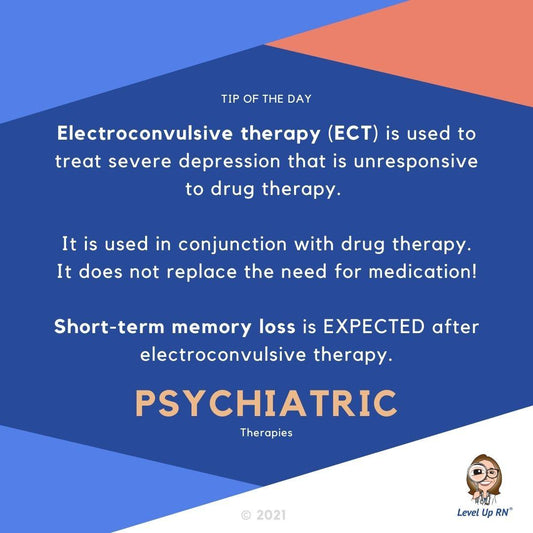
Electroconvulsive Therapy
Electroconvulsive therapy (ECT) is used to treat severe depression that is unresponsive to drug therapy.
Electroconvulsive Therapy
Electroconvulsive therapy (ECT) is used to treat severe depression that is unresponsive to drug therapy.
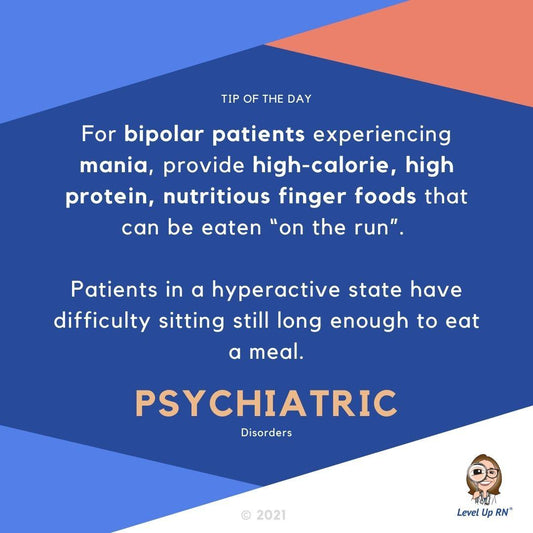
Bipolar patients & mania
For bipolar patients experiencing mania: be sure to provide high-calorie portable snacks (finger foods).
Bipolar patients & mania
For bipolar patients experiencing mania: be sure to provide high-calorie portable snacks (finger foods).
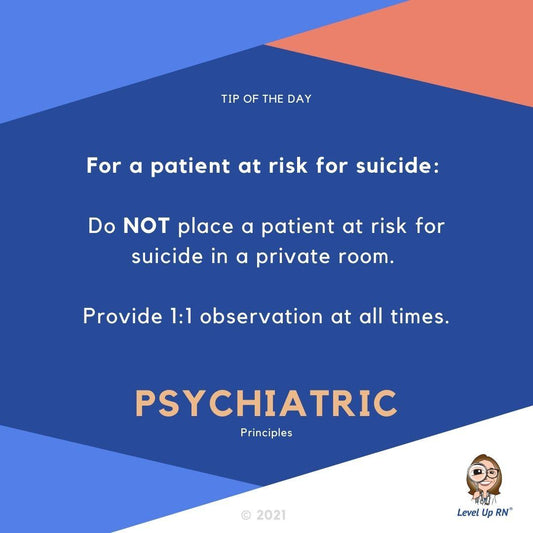
Patient at risk for suicide
For a patient at risk for suicide: Do NOT place a patient at risk for suicide in a private room. Provide 1:1 observation at all times.
Patient at risk for suicide
For a patient at risk for suicide: Do NOT place a patient at risk for suicide in a private room. Provide 1:1 observation at all times.
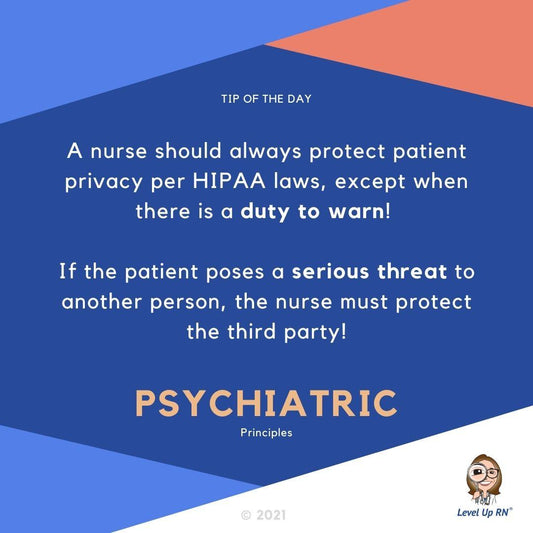
Duty to Warn
A nurse should always protect patient privacy per HIPAA laws, except when there is a duty to warn!
Duty to Warn
A nurse should always protect patient privacy per HIPAA laws, except when there is a duty to warn!
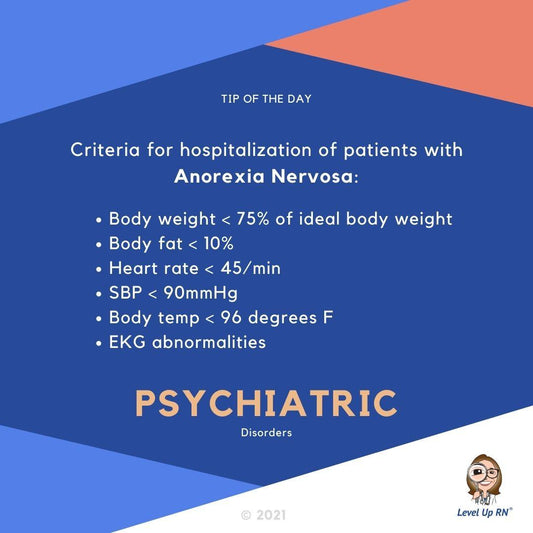
Criteria for hospitalization of patients with anorexia
Criteria for hospitalization of patients with Anorexia Nervosa.
Criteria for hospitalization of patients with anorexia
Criteria for hospitalization of patients with Anorexia Nervosa.
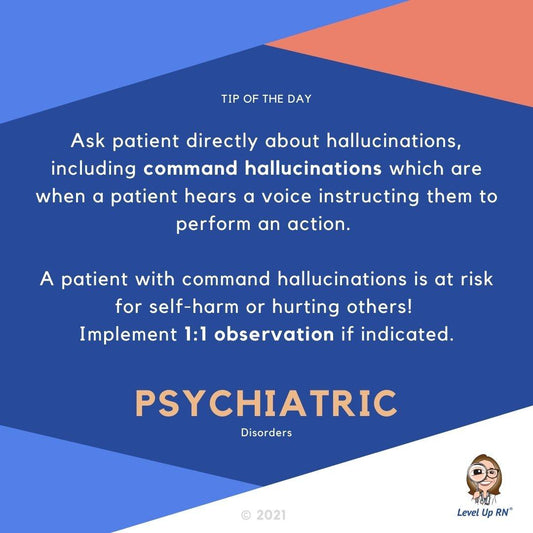
Patient with hallucinations
Ask your patient directly about hallucinations, including command hallucinations. Implement 1:1 observation if indicated!
Patient with hallucinations
Ask your patient directly about hallucinations, including command hallucinations. Implement 1:1 observation if indicated!
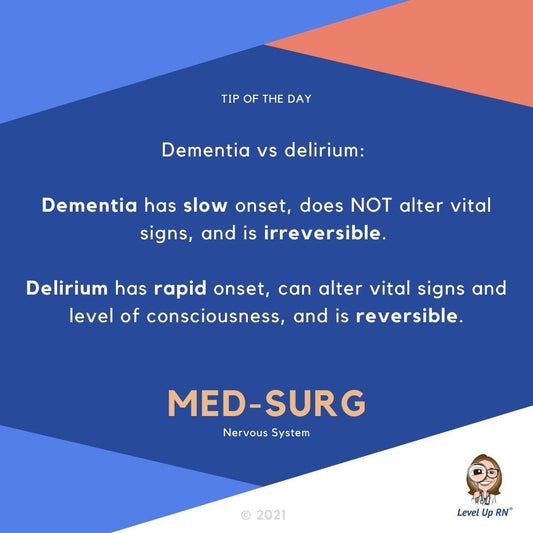
Dementia vs. delirium
Dementia vs delirium: Dementia has slow onset, does NOT alter vital signs, and is irreversible. Delirium has rapid onset, can alter vital signs and level of consciousness, and is reversible.
Dementia vs. delirium
Dementia vs delirium: Dementia has slow onset, does NOT alter vital signs, and is irreversible. Delirium has rapid onset, can alter vital signs and level of consciousness, and is reversible.
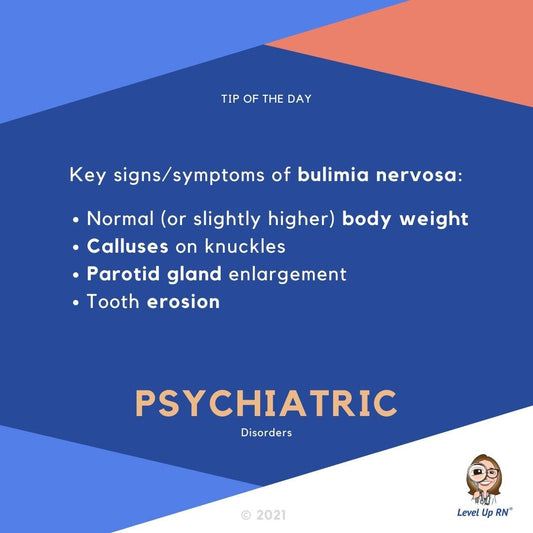
Bulimia Nervosa
Key S&S of bulimia nervosa: normal (or slightly higher) body weight, calluses on knuckles, parotid gland enlargement, tooth erosion.
Bulimia Nervosa
Key S&S of bulimia nervosa: normal (or slightly higher) body weight, calluses on knuckles, parotid gland enlargement, tooth erosion.
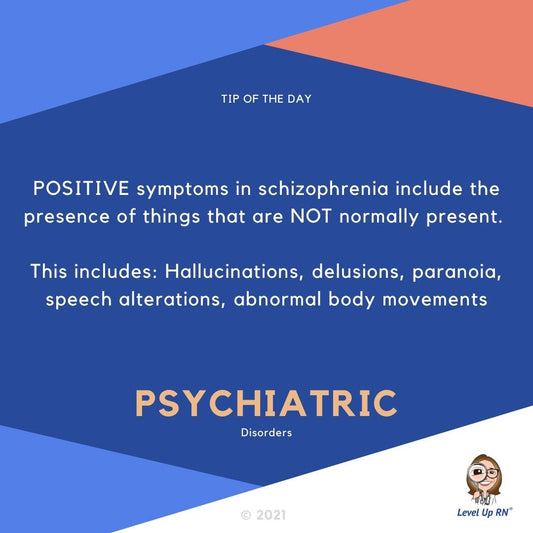
Positive Schizophrenia Symptoms
POSITIVE symptoms in schizophrenia include the presence of things that are NOT normally present.
Positive Schizophrenia Symptoms
POSITIVE symptoms in schizophrenia include the presence of things that are NOT normally present.
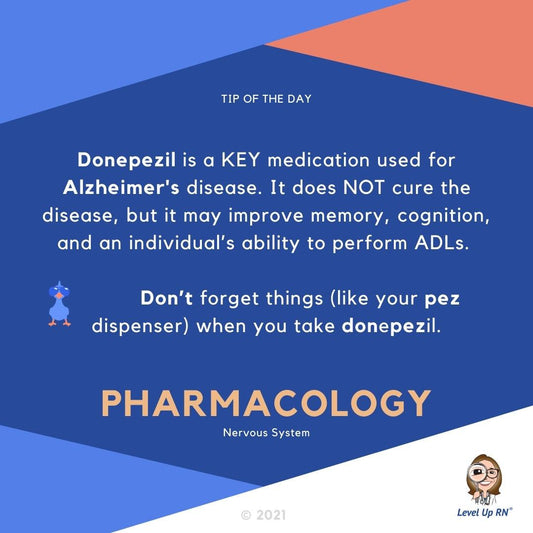
Donepezil & Alzheimer's
Donepezil is a KEY medication used for Alzheimer's disease. It does NOT cure the disease, but it may improve memory, cognition, and an individual’s ability to perform ADLs.
Donepezil & Alzheimer's
Donepezil is a KEY medication used for Alzheimer's disease. It does NOT cure the disease, but it may improve memory, cognition, and an individual’s ability to perform ADLs.
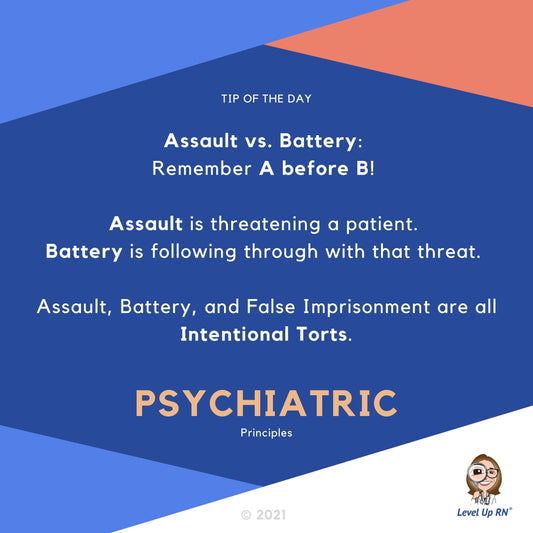
Assault versus Battery
Assault vs. Battery Remember A before B! Assault is threatening a patient, Battery is following through with that threat.
Assault versus Battery
Assault vs. Battery Remember A before B! Assault is threatening a patient, Battery is following through with that threat.
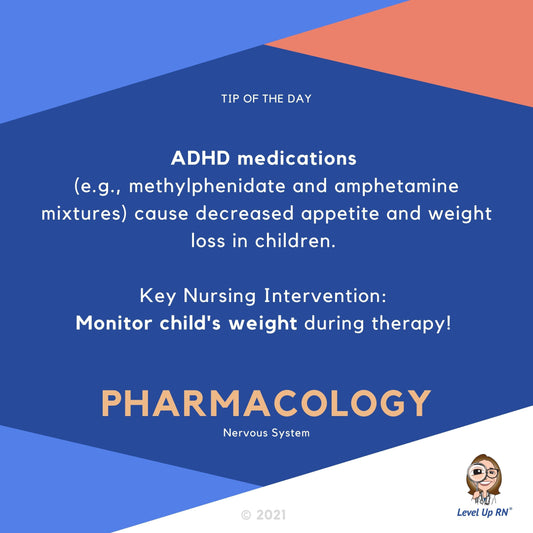
ADHD Medication and Children's Weight
ADHD medications cause decreased appetite and weight loss in children.
ADHD Medication and Children's Weight
ADHD medications cause decreased appetite and weight loss in children.
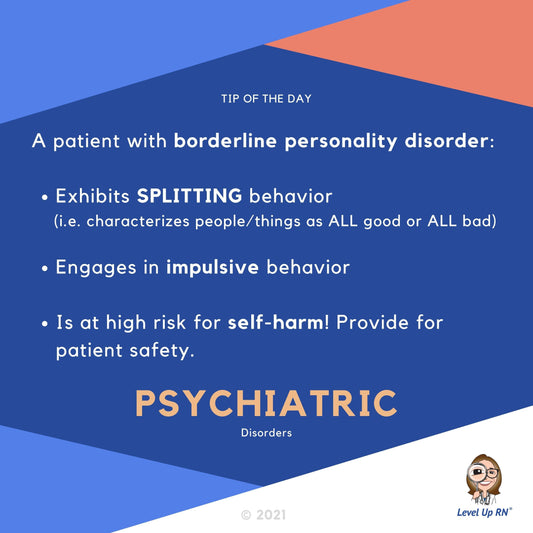
Splitting Behavior
A patient with borderline personality disorder exhibits SPLITTING behavior, engages in impulsive behavior, and is at high risk for self-harm.
Splitting Behavior
A patient with borderline personality disorder exhibits SPLITTING behavior, engages in impulsive behavior, and is at high risk for self-harm.
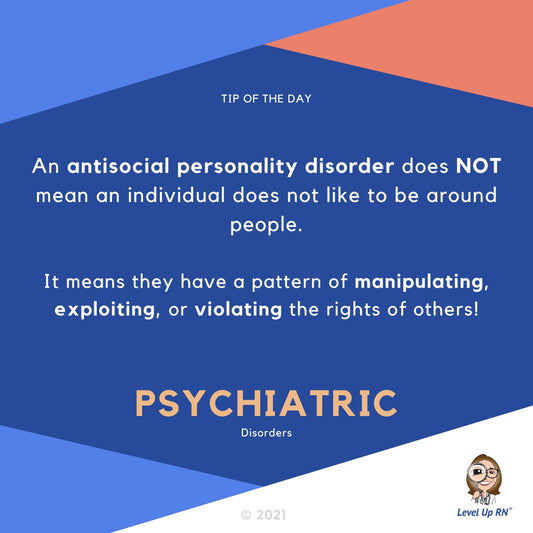
Antisocial personality
An antisocial personality disorder does NOT mean an individual doesn't like to be around people.
Antisocial personality
An antisocial personality disorder does NOT mean an individual doesn't like to be around people.
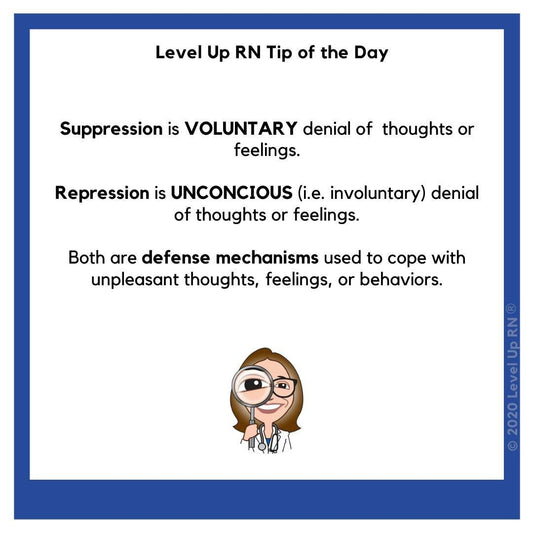
Suppression and Repression
Suppression is VOLUNTARY denial of thoughts or feelings. Repression is UNCONCIOUS (i.e. involuntary) denial of thoughts or feelings.
Suppression and Repression
Suppression is VOLUNTARY denial of thoughts or feelings. Repression is UNCONCIOUS (i.e. involuntary) denial of thoughts or feelings.
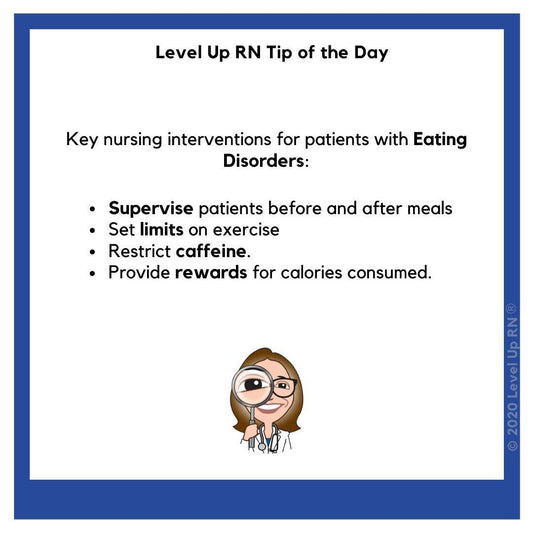
Eating Disorders Key Interventions
Key nursing interventions for patients with Eating Disorders: Supervise before/after meals; Set limits on exercise; Restrict caffeine; Provide rewards for calories consumed.
Eating Disorders Key Interventions
Key nursing interventions for patients with Eating Disorders: Supervise before/after meals; Set limits on exercise; Restrict caffeine; Provide rewards for calories consumed.
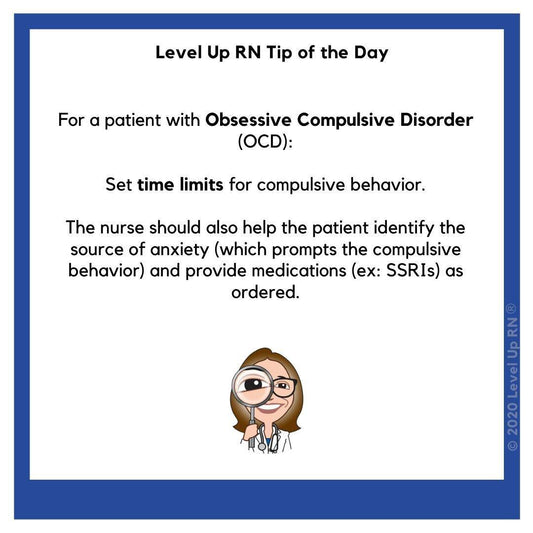
Obsessive Compulsive Disorder
For Obsessive Compulsive Disorder (OCD): Set time limits. Help the patient identify source of anxiety and provide medications as ordered.
Obsessive Compulsive Disorder
For Obsessive Compulsive Disorder (OCD): Set time limits. Help the patient identify source of anxiety and provide medications as ordered.
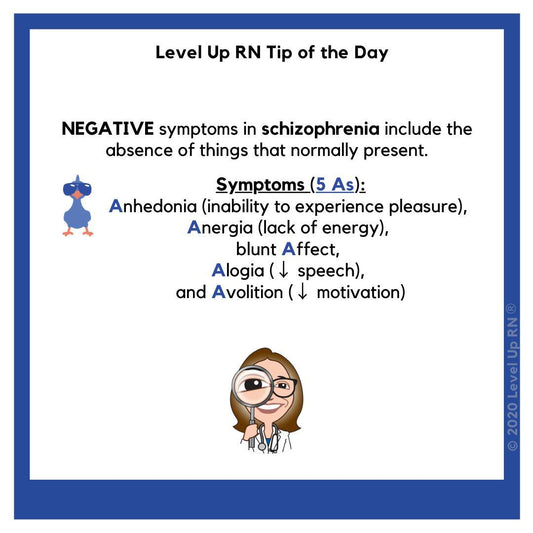
Negative Schizophrenia Symptoms
NEGATIVE symptoms in schizophrenia include the absence of things that normally present. Symptoms (5As): Anhedonia (inability to experience pleasure), Anergia (lack of energy), blunt Affect, Alogia (↓ speech), and Avolition (↓...
Negative Schizophrenia Symptoms
NEGATIVE symptoms in schizophrenia include the absence of things that normally present. Symptoms (5As): Anhedonia (inability to experience pleasure), Anergia (lack of energy), blunt Affect, Alogia (↓ speech), and Avolition (↓...
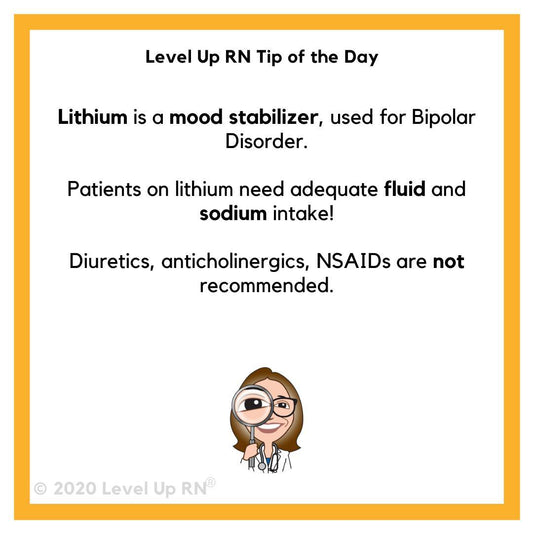
Lithium
Lithium is a mood stabilizer, used for Bipolar Disorder. Patients on lithium need adequate fluid and sodium intake! Diuretics, anticholinergics, NSAIDs are not recommended.
Lithium
Lithium is a mood stabilizer, used for Bipolar Disorder. Patients on lithium need adequate fluid and sodium intake! Diuretics, anticholinergics, NSAIDs are not recommended.
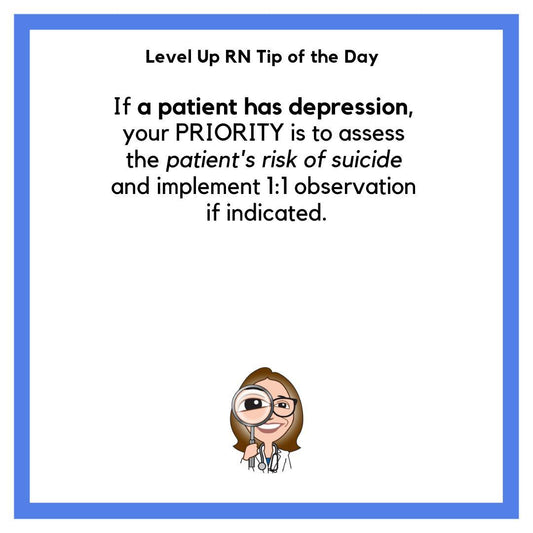
Priority for Patients with Depression
If a patient has depression, your PRIORITY is to assess the patient's risk of suicide and implement 1:1 observation if indicated.
Priority for Patients with Depression
If a patient has depression, your PRIORITY is to assess the patient's risk of suicide and implement 1:1 observation if indicated.
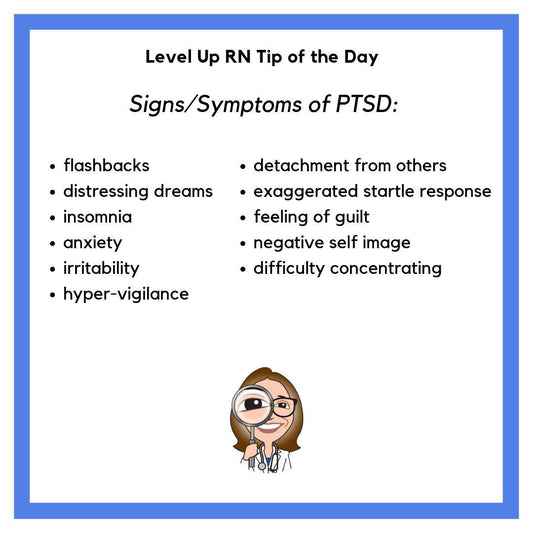
Signs and Symptoms of PTSD
Signs/Symptoms of PTSD: flashbacks, distressing dreams, difficulty concentrating, insomnia, anxiety, irritability, detachment from others, hyper-vigilance, exaggerated startle response, feeling of guilt, and negative self-image.
Signs and Symptoms of PTSD
Signs/Symptoms of PTSD: flashbacks, distressing dreams, difficulty concentrating, insomnia, anxiety, irritability, detachment from others, hyper-vigilance, exaggerated startle response, feeling of guilt, and negative self-image.
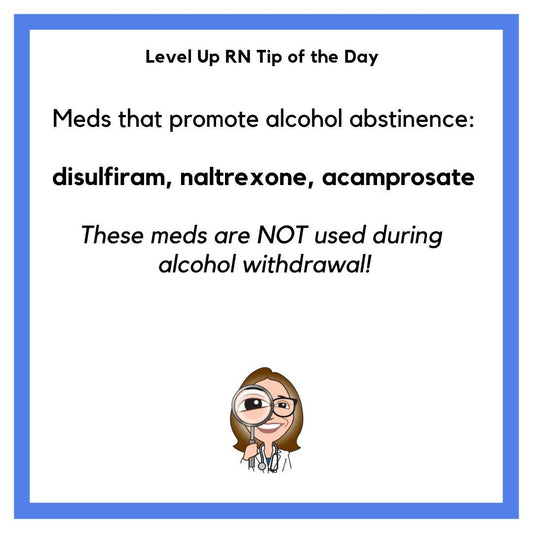
Meds that Promote Alcohol Abstinence
Meds that promote alcohol abstinence: disulfiram, naltrexone, acamprosate. These meds are NOT used during alcohol withdrawal!
Meds that Promote Alcohol Abstinence
Meds that promote alcohol abstinence: disulfiram, naltrexone, acamprosate. These meds are NOT used during alcohol withdrawal!
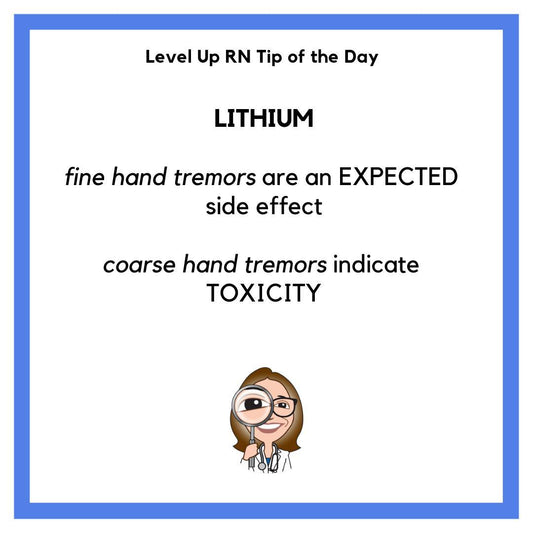
Lithium Side Effects vs. Toxicity
Lithium: fine hand tremors are an EXPECTED side effect, coarse hand tremors indicate TOXICITY.
Lithium Side Effects vs. Toxicity
Lithium: fine hand tremors are an EXPECTED side effect, coarse hand tremors indicate TOXICITY.
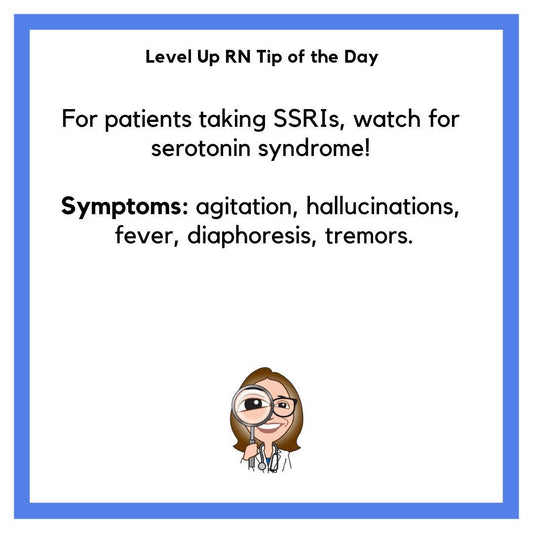
SSRIs and Serotonin Syndrome
For patients taking SSRIs, watch for serotonin syndrome! Symptoms: agitation, hallucinations, fever, diaphoresis, tremors.
SSRIs and Serotonin Syndrome
For patients taking SSRIs, watch for serotonin syndrome! Symptoms: agitation, hallucinations, fever, diaphoresis, tremors.
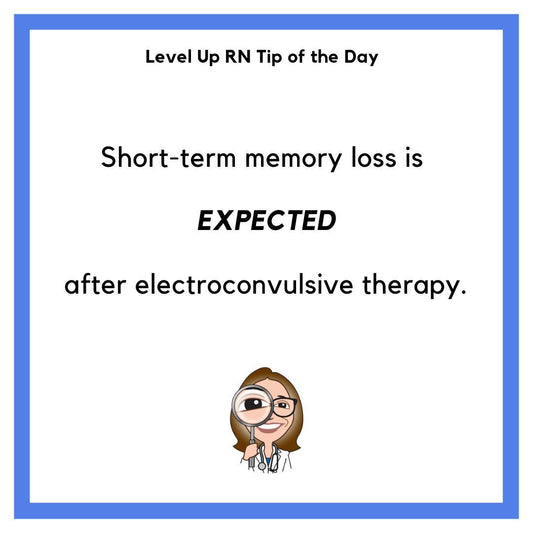
Electro convulsive therapy
Short-term memory loss is EXPECTED after electroconvulsive therapy.
Electro convulsive therapy
Short-term memory loss is EXPECTED after electroconvulsive therapy.
Filter Articles
Shop
The Ultimate Nursing School Survival Kit - with Flashables and Membership
4.875 / 5.0
(240) 240 total reviews
Regular price $349.95Regular priceUnit price / per$817.95Sale price $349.95SaleVideos by Subject
Tips & More
Exam Information
Subscribe

